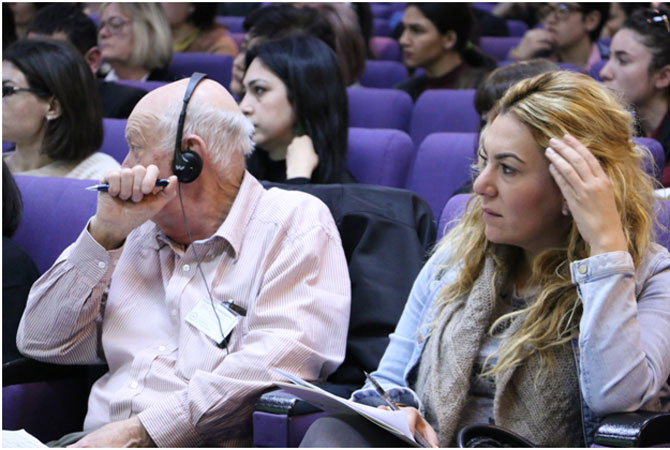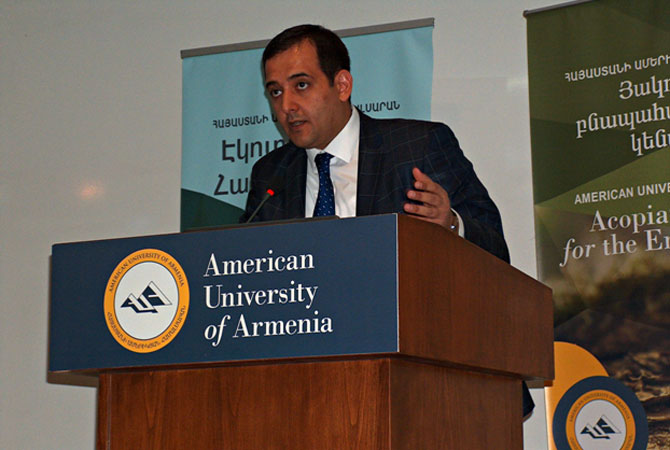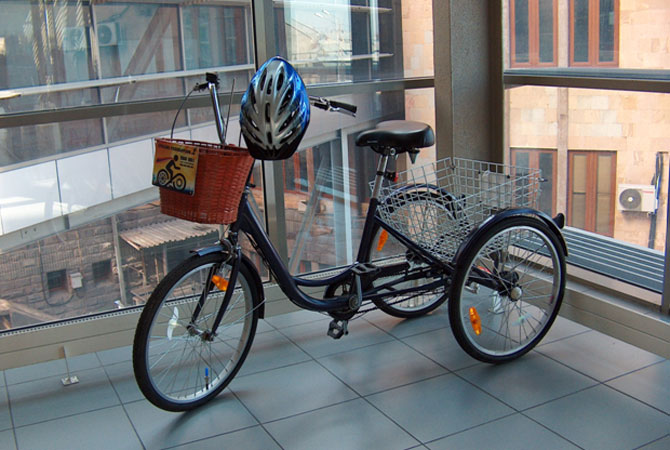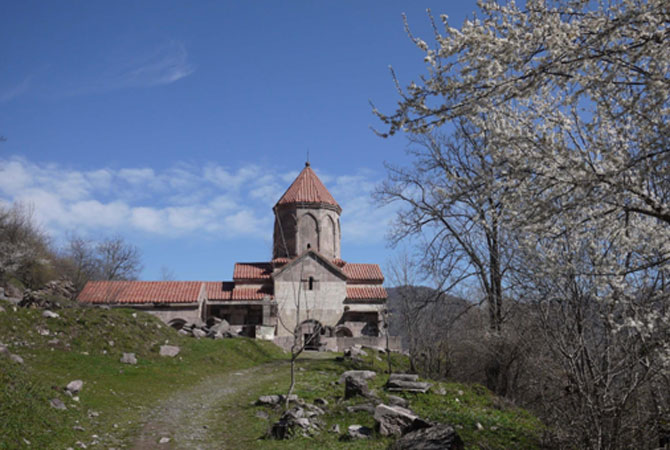
AUA’s First Conference on Ecotourism Paves Way for Responsible Tourism in Armenia
By Karine Vann
In the last decade, ecotourism has emerged as a developing industry in Armenia, paralleling the steady growth of tourism in general, which according to a 2016 economic impact report by the World Travel and Tourism Council, expects a 4% increase in contribution to GDP this year alone.
Despite this fact, most people--even some claiming to be operating with ‘green’ principles in mind--don’t really know much about it. Frankly, even the international definition is quite vague.
The question, then, is not whether businesses should welcome ecotourism principles as a positive trend in tourism, but rather how can businesses and NGOs go about abiding by and implementing eco-friendly, sustainable standards in a place like Armenia, where many core ideological values are not yet commonplace?
These were questions that American University of Armenia’s Acopian Center for the Environment (ACE) sought to address last Saturday, April 2, when they hosted Armenia’s first ever Ecotourism Conference. Up to 500 people from over 100 different organizations participated in the conference over the course of the day’s activities, which lasted from 11 am to 6:30 pm. The event was free and open to the public. Over 40 speakers presented during 11 sessions and the event was live-streamed on AUA’s YouTube channel.

Photo credit: Vahan Amatunyan/AUA Acopian Center for the Environment
The conference was held primarily in Armenian, with simultaneous Armenian to English translations available in Manoogian Hall the entire day. The structure followed a series of general presentations by larger players in the industry taking place in Manoogian hall. In between the 3 general sessions were held 2 sets of smaller, simultaneously-occurring sessions which grouped speakers based on a particular theme (for example, ‘Tourist expectations,’ ‘Adventure Tourism,’ or ‘Setting up an ecotourism business’).
Welcoming remarks by AUA Provost Randall Rhodes introduced the urgency of developing this growing industry within the context of the Smithsonian Institute’s 4-year-long initiative announced last November to promote Armenia as an international tourist destination and drive activity into regions outside of Yerevan. Brief presentations followed from representatives of Armenia’s Ministry of Economy and Ministry of Nature Protection. Yet participation from government officials at the conference was far from being the event’s highlight.

Deputy Minister Khachig Hakobyan, Armenia’s Ministry of Nature Protection speaking at the Ecotourism Conference’s opening remarks. Photo credit: Liana Hakobyan/AUA Acopian Center for the Environment
The conference was a milestone for offering a platform for a wide variety of organizations across the board, ranging in scope and function, to be transparent about their work in Armenia’s respective regions. Represented were massive players, like the World Bank, who has been investing heavily in small grant opportunities for villages, as well as smaller, grass-roots efforts, like ARK Armenia, an NGO marking hiking trails, building eco-camps, and hosting volunteers in Kapan.

Representatives of the Federation of Amateur Cycling and Cycle Tourism presented their organization at the conference. Photo credit: Liana Hakobyan/AUA Acopian Center for the Environment
Also represented were some promising businesses operating by environmentally-friendly principles, like Nairian, a company producing the first ever Armenian all-natural cosmetics made from plants and herbs harvested in the country’s highlands, and Apaga Resort, a resort based in Yenokavan that offers ziplining and horseback-riding and hosts an impressive 30,000 tourists per year.
The event was also valuable for encouraging individuals and business to voice their concerns about the current status of Armenia’s tourism industry. Argishti Mikayelyan, owner of Vayk Hotel in Vayots Dzor, commented on the negative effects of outdated models of tourism, “Agrotourism and tourism in Armenia will develop further only after we shift our focus from church tourism and start delving deeper into our villages, rural zones, and natural habitats. From our investigations, tourists come to Armenia to see nature, village food, traditions, and agriculture. But instead, we force feed them only ancient cultural artifacts and agriculture.”

While Armenia’s churches are a valuable cultural asset, audience members of the conference criticized over-emphasis on them as a tourist attraction vs. Armenia’s nature and villages. Photo credit: ARK Armenia
The event was impressive for getting together many individuals and organizations from all corners of the country. AUA has not yet released official numbers, but when ACE Director Alen Amirkhanian asked audience members how many came from a region or village outside Yerevan, a sea of hands comprising over half the room was visible.
While the conference was a promising step in the right direction, it was not without its hiccups, notably the absence of smaller, international organizations from neighboring countries. Ones that were present, however, expressed frustration at being unable to participate in the conference’s smaller sessions where local organizations presented their work, due to the lack of simultaneous English translations outside of Manoogian Hall.
Of these, the Transcaucasian Trail (TCT), a registered US non-profit based in Washington DC and Tbilisi, was a notable addition to the roster. The non-profit aims to develop a world-class network of cross-border hiking trails across the Caucasus region in phases over the next five years. “There is so much potential for ecotourism in the region and promoting conversation about it can only help,” said TCT representative Laura Santos-Bishop, who felt the conference was significant for the scope. Also present were individuals responsible for the scouting and marking of the trail’s Armenian component, the Transarmenian Trail, which will span over 500km, starting in the Lori region and ending in Syunik on the border with Iran.
The conference also demonstrated that the art of presentation, much like ecotourism itself, is still a developing concept in Armenia. Few presenters were able to stay on topic in terms of providing practical information about their experiences and obstacles. Instead, many presented slides saturated with text, repeatedly citing the same worrying statistics about Armenia’s protected areas and situation with mining, and few offering any solutions. Even fewer stuck to the 10-minute mark allotted to presenters, despite the fact that moderators had been assigned to each room, meaning that hardly any time was left for questions after each presentation.
Next year, organizers might consider including a larger session on marketing techniques, inviting professionals from creative spheres not directly related to ecotourism, like graphic design and content writing. The hope is that this would create a clear avenue to connect with well-established tour operators working in Yerevan, like for example Hyur Service, many of which have access to large demographics of international tourists. As ‘green’ businesses are proving lucrative worldwide, creative professionals in Armenia, it seems, could certainly benefit from developing such relationships.
Overall, AUA representatives say that feedback from the conference was overwhelmingly positive, with many requesting similar events in the future where discussions are participatory and focused on experiences and solutions. Conference resources, such as maps, a database and slides from all presenters at the conference, will be available for download on AUA’s website later this week.
Top photo credit: Tom Allen/Transarmenian Trail
Karine Vann is a freelance writer, graphic designer, and activist based in Yerevan, originally from the Washington D.C. area. She is a musician by training and is passionate about the arts and the environment (in no particular order).
 Videos
Videos Photos
Photos
Comments (1)
Write a comment